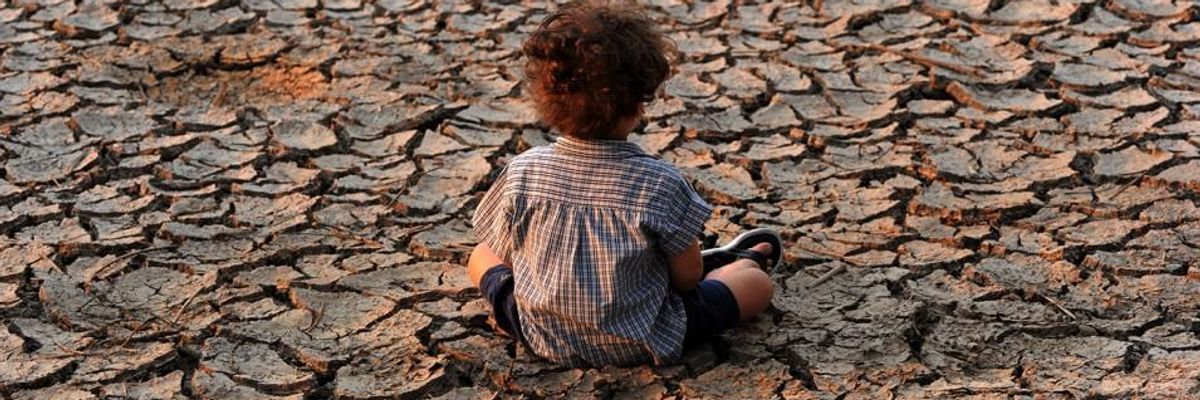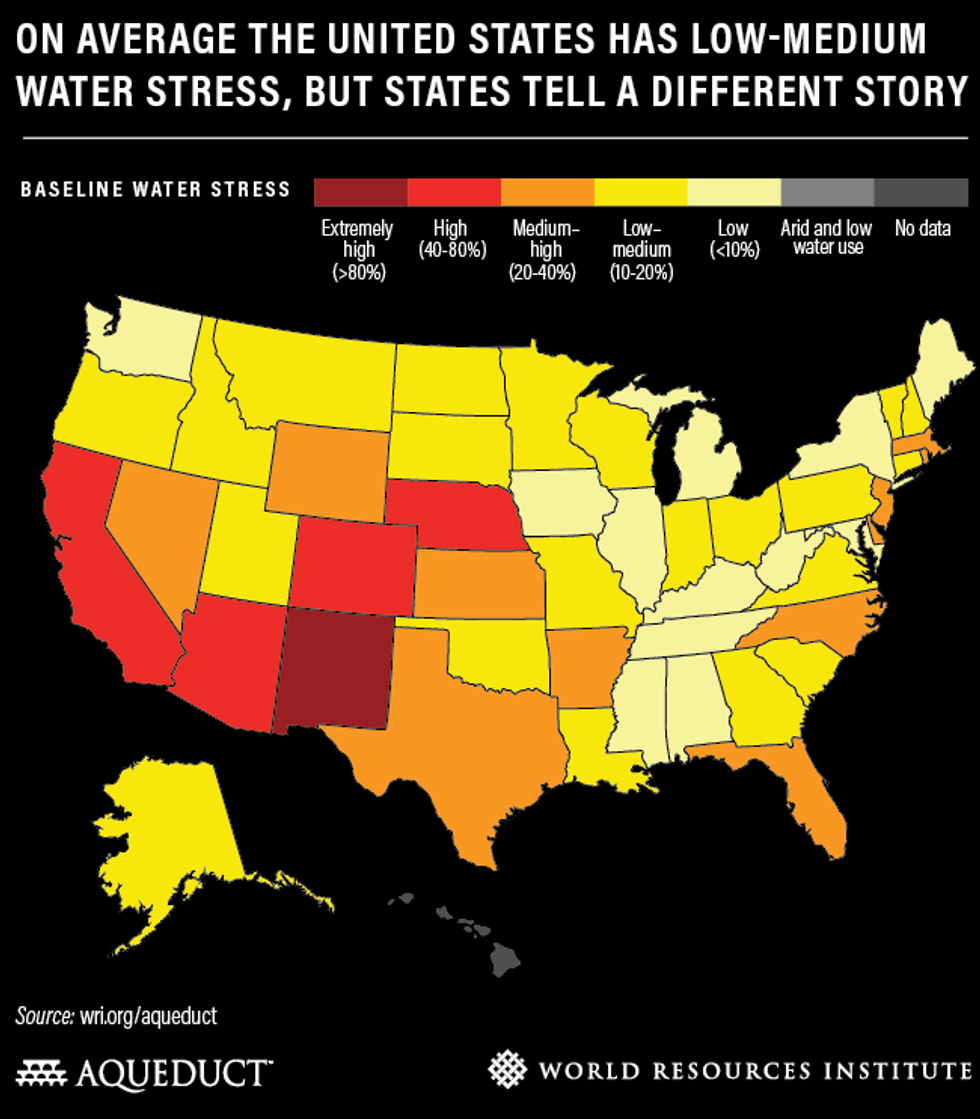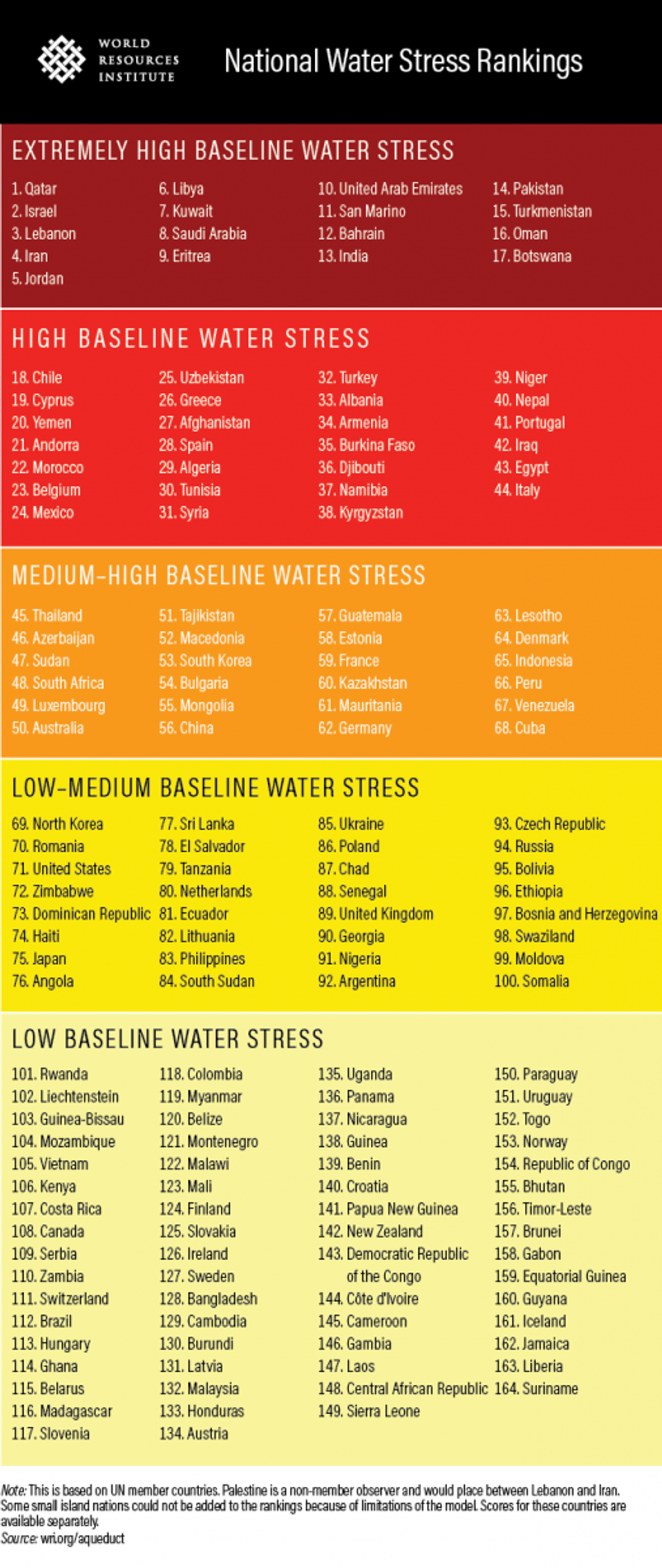

SUBSCRIBE TO OUR FREE NEWSLETTER
Daily news & progressive opinion—funded by the people, not the corporations—delivered straight to your inbox.
5
#000000
#FFFFFF
To donate by check, phone, or other method, see our More Ways to Give page.


Daily news & progressive opinion—funded by the people, not the corporations—delivered straight to your inbox.

A child sits in an area affected by a drought in the southern outskirts of Tegucigalpa, Honduras, in 2016. In the same area this September, the Honduran government declared a state of emergency because of drought as 290 municipalities are on the verge of running out of food. (Photo: Orlando Sierra/Stringer/Getty Images)
An analysis released Tuesday warns that 17 countries which are collectively home to a quarter of the global population face "extremely high water stress" that is on track to get worse--particularly because of the human-caused climate emergency.
The data is part of the World Resources Institute's (WRI) Aqueduct Water Risk Atlas, a publicly available database and interactive tool designed to enhance global understanding of water scarcity, which WRI calls "one of the defining issues of the 21st century."
"The newly updated Aqueduct tools allow users to better see and understand water risks and make smart decisions to manage them," WRI president and CEO Andrew Steer said in a statement. "A new generation of solutions is emerging, but nowhere near fast enough. Failure to act will be massively expensive in human lives and livelihoods."
\u201c#DayZeroWatch - New @WRIAqueduct data shows which countries are facing #waterstress, and reveals several emerging trends and hotspots. Learn more: https://t.co/XJkY3VcP7I\u201d— World Resources Inst (@World Resources Inst) 1565096713
"Water stress is the biggest crisis no one is talking about," said Steer. "Its consequences are in plain sight in the form of food insecurity, conflict and migration, and financial instability."
The WRI statement noted that "the world has seen a string of water crises in recent years, as what's now known as 'Day Zero'--the day when the taps run dry--has threatened major cities from Cape Town to Sao Paolo to Chennai."
Betsy Otto, who directs WRI's global water program, told The New York Times that "we're likely to see more of these Day Zeros in the future."
Otto, speaking to The Guardian, added that "our populations and economies are growing and demanding more water. But our supply is threatened by climate change, water waste, and pollution."
In a blog post announcing the new data, WRI outlined three ways that communities and countries around the world can reduce water stress, regardless of where they rank on the group's list:
The blog explained that countries rank at WRI's highest level for water stress if their "irrigated agriculture, industries, and municipalities withdraw more than 80 percent of their available supply on average every year."
A dozen of the top-ranked countries are located in the Middle East and North Africa. "The region is hot and dry, so water supply is low to begin with," wrote WRI, "but growing demands have pushed countries further into extreme stress."
\u201c@WorldResources @WRIAqueduct @WaterAidUK @wateraid @UN_Water @WRIClimate @FAOWater @WorldBank \ud83c\uddf6\ud83c\udde6 Qatar is the most water-stressed country, followed by \ud83c\uddee\ud83c\uddf1Israel and \ud83c\uddf1\ud83c\udde7 Lebanon\u201d— Context Climate (@Context Climate) 1565091279
India, which has a population exceeding 1.3 billion, also ranks among the most water-stressed nations.
Shashi Shekhar--former secretary of India's Ministry of Water Resources and a senior fellow at WRI India--noted that "the recent water crisis in Chennai gained global attention, but various areas in India are experiencing chronic water stress as well."
"India can manage its water risk with the help of reliable and robust data pertaining to rainfall, surface, and groundwater to develop strategies that strengthen resilience," Shekhar said. "Aqueduct can help identify and prioritize water risks in India and around the world."
Behind the 17 nations at WRI's top level are 44 countries--collectively home to another third of the world's population--that face "high" water stress, withdrawing on average more than 40 percent of their available supply annually.
However, as WRI's blog post pointed out, "pockets of extreme water stress exist even in countries with low overall water stress."
"For example, South Africa and the United States rank #48 and #71 on WRI's list, respectively, yet the Western Cape (the state home to Cape Town) and New Mexico experience extremely high stress levels," the group explained. "The populations in these two states rival those of entire nations on the list of most water-stressed countries."

"The data is clear: There are undeniably worrying trends in water," WRI concluded. "But by taking action now and investing in better management, we can solve water issues for the good of people, economies and the planet."
See the group's full ranking--which is based on United Nations member countries and does not include some small island nations due to model limitations--below:

Donald Trump’s attacks on democracy, justice, and a free press are escalating — putting everything we stand for at risk. We believe a better world is possible, but we can’t get there without your support. Common Dreams stands apart. We answer only to you — our readers, activists, and changemakers — not to billionaires or corporations. Our independence allows us to cover the vital stories that others won’t, spotlighting movements for peace, equality, and human rights. Right now, our work faces unprecedented challenges. Misinformation is spreading, journalists are under attack, and financial pressures are mounting. As a reader-supported, nonprofit newsroom, your support is crucial to keep this journalism alive. Whatever you can give — $10, $25, or $100 — helps us stay strong and responsive when the world needs us most. Together, we’ll continue to build the independent, courageous journalism our movement relies on. Thank you for being part of this community. |
An analysis released Tuesday warns that 17 countries which are collectively home to a quarter of the global population face "extremely high water stress" that is on track to get worse--particularly because of the human-caused climate emergency.
The data is part of the World Resources Institute's (WRI) Aqueduct Water Risk Atlas, a publicly available database and interactive tool designed to enhance global understanding of water scarcity, which WRI calls "one of the defining issues of the 21st century."
"The newly updated Aqueduct tools allow users to better see and understand water risks and make smart decisions to manage them," WRI president and CEO Andrew Steer said in a statement. "A new generation of solutions is emerging, but nowhere near fast enough. Failure to act will be massively expensive in human lives and livelihoods."
\u201c#DayZeroWatch - New @WRIAqueduct data shows which countries are facing #waterstress, and reveals several emerging trends and hotspots. Learn more: https://t.co/XJkY3VcP7I\u201d— World Resources Inst (@World Resources Inst) 1565096713
"Water stress is the biggest crisis no one is talking about," said Steer. "Its consequences are in plain sight in the form of food insecurity, conflict and migration, and financial instability."
The WRI statement noted that "the world has seen a string of water crises in recent years, as what's now known as 'Day Zero'--the day when the taps run dry--has threatened major cities from Cape Town to Sao Paolo to Chennai."
Betsy Otto, who directs WRI's global water program, told The New York Times that "we're likely to see more of these Day Zeros in the future."
Otto, speaking to The Guardian, added that "our populations and economies are growing and demanding more water. But our supply is threatened by climate change, water waste, and pollution."
In a blog post announcing the new data, WRI outlined three ways that communities and countries around the world can reduce water stress, regardless of where they rank on the group's list:
The blog explained that countries rank at WRI's highest level for water stress if their "irrigated agriculture, industries, and municipalities withdraw more than 80 percent of their available supply on average every year."
A dozen of the top-ranked countries are located in the Middle East and North Africa. "The region is hot and dry, so water supply is low to begin with," wrote WRI, "but growing demands have pushed countries further into extreme stress."
\u201c@WorldResources @WRIAqueduct @WaterAidUK @wateraid @UN_Water @WRIClimate @FAOWater @WorldBank \ud83c\uddf6\ud83c\udde6 Qatar is the most water-stressed country, followed by \ud83c\uddee\ud83c\uddf1Israel and \ud83c\uddf1\ud83c\udde7 Lebanon\u201d— Context Climate (@Context Climate) 1565091279
India, which has a population exceeding 1.3 billion, also ranks among the most water-stressed nations.
Shashi Shekhar--former secretary of India's Ministry of Water Resources and a senior fellow at WRI India--noted that "the recent water crisis in Chennai gained global attention, but various areas in India are experiencing chronic water stress as well."
"India can manage its water risk with the help of reliable and robust data pertaining to rainfall, surface, and groundwater to develop strategies that strengthen resilience," Shekhar said. "Aqueduct can help identify and prioritize water risks in India and around the world."
Behind the 17 nations at WRI's top level are 44 countries--collectively home to another third of the world's population--that face "high" water stress, withdrawing on average more than 40 percent of their available supply annually.
However, as WRI's blog post pointed out, "pockets of extreme water stress exist even in countries with low overall water stress."
"For example, South Africa and the United States rank #48 and #71 on WRI's list, respectively, yet the Western Cape (the state home to Cape Town) and New Mexico experience extremely high stress levels," the group explained. "The populations in these two states rival those of entire nations on the list of most water-stressed countries."

"The data is clear: There are undeniably worrying trends in water," WRI concluded. "But by taking action now and investing in better management, we can solve water issues for the good of people, economies and the planet."
See the group's full ranking--which is based on United Nations member countries and does not include some small island nations due to model limitations--below:

An analysis released Tuesday warns that 17 countries which are collectively home to a quarter of the global population face "extremely high water stress" that is on track to get worse--particularly because of the human-caused climate emergency.
The data is part of the World Resources Institute's (WRI) Aqueduct Water Risk Atlas, a publicly available database and interactive tool designed to enhance global understanding of water scarcity, which WRI calls "one of the defining issues of the 21st century."
"The newly updated Aqueduct tools allow users to better see and understand water risks and make smart decisions to manage them," WRI president and CEO Andrew Steer said in a statement. "A new generation of solutions is emerging, but nowhere near fast enough. Failure to act will be massively expensive in human lives and livelihoods."
\u201c#DayZeroWatch - New @WRIAqueduct data shows which countries are facing #waterstress, and reveals several emerging trends and hotspots. Learn more: https://t.co/XJkY3VcP7I\u201d— World Resources Inst (@World Resources Inst) 1565096713
"Water stress is the biggest crisis no one is talking about," said Steer. "Its consequences are in plain sight in the form of food insecurity, conflict and migration, and financial instability."
The WRI statement noted that "the world has seen a string of water crises in recent years, as what's now known as 'Day Zero'--the day when the taps run dry--has threatened major cities from Cape Town to Sao Paolo to Chennai."
Betsy Otto, who directs WRI's global water program, told The New York Times that "we're likely to see more of these Day Zeros in the future."
Otto, speaking to The Guardian, added that "our populations and economies are growing and demanding more water. But our supply is threatened by climate change, water waste, and pollution."
In a blog post announcing the new data, WRI outlined three ways that communities and countries around the world can reduce water stress, regardless of where they rank on the group's list:
The blog explained that countries rank at WRI's highest level for water stress if their "irrigated agriculture, industries, and municipalities withdraw more than 80 percent of their available supply on average every year."
A dozen of the top-ranked countries are located in the Middle East and North Africa. "The region is hot and dry, so water supply is low to begin with," wrote WRI, "but growing demands have pushed countries further into extreme stress."
\u201c@WorldResources @WRIAqueduct @WaterAidUK @wateraid @UN_Water @WRIClimate @FAOWater @WorldBank \ud83c\uddf6\ud83c\udde6 Qatar is the most water-stressed country, followed by \ud83c\uddee\ud83c\uddf1Israel and \ud83c\uddf1\ud83c\udde7 Lebanon\u201d— Context Climate (@Context Climate) 1565091279
India, which has a population exceeding 1.3 billion, also ranks among the most water-stressed nations.
Shashi Shekhar--former secretary of India's Ministry of Water Resources and a senior fellow at WRI India--noted that "the recent water crisis in Chennai gained global attention, but various areas in India are experiencing chronic water stress as well."
"India can manage its water risk with the help of reliable and robust data pertaining to rainfall, surface, and groundwater to develop strategies that strengthen resilience," Shekhar said. "Aqueduct can help identify and prioritize water risks in India and around the world."
Behind the 17 nations at WRI's top level are 44 countries--collectively home to another third of the world's population--that face "high" water stress, withdrawing on average more than 40 percent of their available supply annually.
However, as WRI's blog post pointed out, "pockets of extreme water stress exist even in countries with low overall water stress."
"For example, South Africa and the United States rank #48 and #71 on WRI's list, respectively, yet the Western Cape (the state home to Cape Town) and New Mexico experience extremely high stress levels," the group explained. "The populations in these two states rival those of entire nations on the list of most water-stressed countries."

"The data is clear: There are undeniably worrying trends in water," WRI concluded. "But by taking action now and investing in better management, we can solve water issues for the good of people, economies and the planet."
See the group's full ranking--which is based on United Nations member countries and does not include some small island nations due to model limitations--below:
